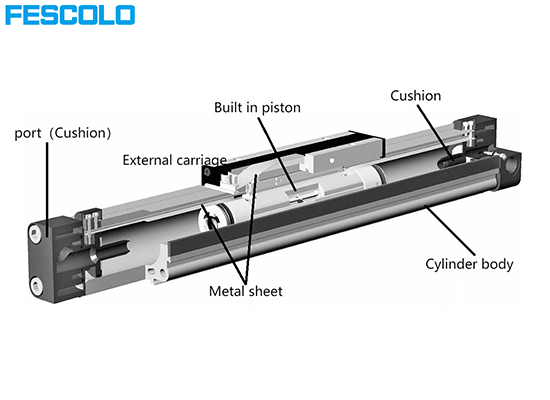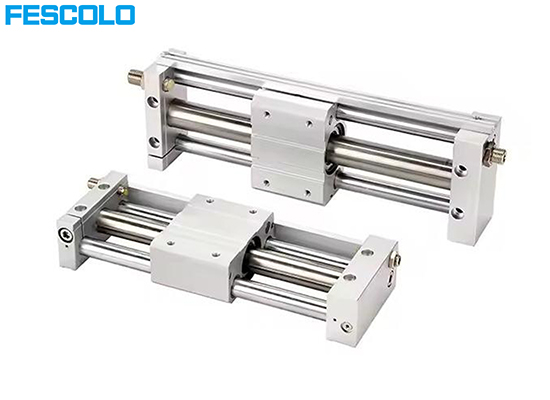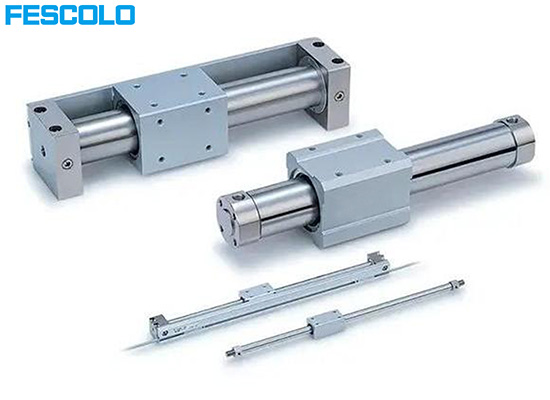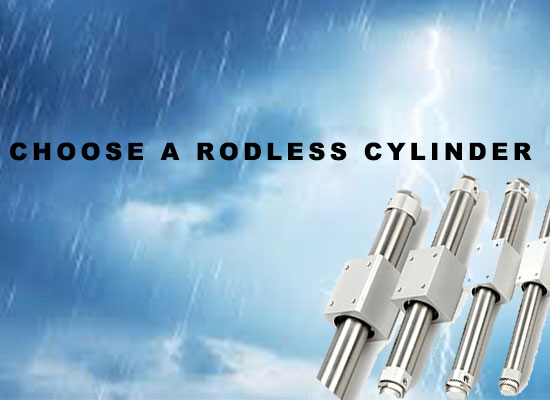Feb 05, 2025
Rodless cylinders are generally of the pneumatic drive type, with two driving modes: single acting and double acting. Single acting refers to a compressed air chamber, while double acting refers to two compressed air chambers, with stronger thrust. Rod free pneumatic cylinders are widely used in fields such as automation, handling, and clamping.
A rodless cylinder is an innovative type of pneumatic cylinder actuator that achieves linear motion without the need for an external piston rod. The internal piston moves along the axis of the cylinder through changes in internal air pressure.
As equipment continues to move toward higher efficiency and greater compactness, rodless air cylinder, with their unique structural advantages, have become an important choice for saving space and enhancing performance. To help you better understand rodless cylinders and their applications, we will introduce their working principles, main types, product features, advantages and disadvantages, as well as key points to consider during use in the following sections.

To explore how a rodless cylinder works, let's take the mechanically coupled rodless Pneumatic cylinder as an example. It primarily consists of an internal piston that moves within the cylinder barrel, driven by compressed air supplied from both ends. A carriage is mounted externally on the pneumatic cylinder actuator, and the connection between the piston and the carriage is achieved through a metal band. Cushions are installed at both ends of the piston to prevent sudden stops.

The detailed working steps of rodless pneumatic cylinders are as follows:
Precondition:Like any cylinders, rodless cylinder actuators must have a sealed design to maintain air pressure and prevent contaminants from entering.
Internal Piston Movement:Within the sealed air cylinder, there is an internal piston that moves along the axis of the cylinder barrel.
Connecting the Piston to the Carriage:The purpose of the piston's movement is to drive the carriage or an attached load. The external carriage serves as a bridge connecting the piston to the load.
Tips
There are three main ways to connect the rodless piston to the carriage
Slot Connection: A slotted opening with a sealing band is built into the roldess cylinder to prevent air leakage. The piston is connected to the carriage through this slot.
Magnetic Coupling: Strong magnets are embedded in both the piston and the carriage, allowing the carriage to move along with the piston.
Cable Connection: A cable linking the internal piston to the external carriage enables the carriage to move as the piston moves.
External Transportation:Once the carriage is installed, it moves along with the internal piston via one of the three connection methods, either directly or indirectly.
Carriage Movement:When air pressure drives the piston to move forward or backward, the piston in turn drives the external carriage along the pneumatic rodless cylinder, carrying the load or object that needs to be moved.
Many industries utilize various types of rodless cylinder pneumatic, such as magnetic cylinders, magnetically coupled rodless cylinders, as well as other types like slotted and cable-driven rodless cylinders. Magnetic and magnetically coupled rodless cylinders are considered more specialized in terms of functionality and value.
A magnetic rodless cylinder is a type of pneumatic cylinder actuator that provides linear motion without the need for an external piston rod. It uses a magnetic coupling mechanism to transfer the movement of the internal piston to the external carriage.
The greatest advantage of magnetic rodless cylinders lies in their structural characteristics, allowing for compact and efficient use of space, making them ideal for industrial applications where space is limited.

A magnetically coupled rodless cylinder provides linear motion without the need for an external piston rod. It transfers motion using magnetic coupling between the internal piston and the external carriage.

The slotted rodless cylinders feature a longitudinal slot along its length. This slot allows the internal piston to connect directly to the external carriage, which moves along the outer surface of the cylinder. This design enables linear motion without an extending piston rod, making it particularly suitable for applications with limited space.
The cable-driven rodless cylinders deliver linear motion without the need for an extending or retracting piston rod. It uses a cable system to transfer the internal piston's movement to the external carriage. This space-saving design is ideal for applications requiring long strokes in confined spaces.
There are many benefits to using rodless pneumatic air cylinders, but at the same time, there are also many limitations,the following advantages and disadvantages of rodless cylinder can deepen your impression:
Advantages:
The most obvious advantage of Pneumatic rodless cylinder is its long stroke capability. It is not limited by the length of a piston rod, allowing the overall length of the cylinder to be nearly equal to the stroke length.
Their shorter overall length makes rodless cylinders ideal for tight spaces.
Equipped with mounting grooves on various sides,rodless cylinders support the direct integration of modular components like brakes and sensors.
The use of inner and outer sealing bands ensure rodless cylinders reliable sealing performance, even for long strokes.
Disadvantages:
The rodless design demands excellent sealing between the cylinder barrel and the carriage, making it prone to air leakage due to wear over time.
Compared to traditional rod-type cylinders, rodless cylinders are more complex to manufacture, resulting in higher procurement and maintenance costs.
Rodless cylinders have limited ability to withstand lateral loads. Excessive side forces can shorten the carriage's lifespan or cause movement jams.
Precise installation and alignment are necessary; otherwise, abnormal wear or unsmooth motion can occur.

Piston Stroke Length: The distance the cylinder moves back and forth determines the length of the piston's movement. Ensure it meets your requirements.
Load Capacity: When selecting a rodless cylinder, you must consider the weight it can bear.
Speed: Some rodless cylinders are faster than others, so choose one that meets your speed requirements.
Installation Options: Mounting the cylinder to your machine or equipment varies by cylinder type, so ensure proper installation.
Space: Rodless cylinders do not require an extending rod, saving space, so consider the available movement space for the cylinder.
Common Applications of Pnemuatic Rodless Cylinders
Rodless air cylinders are used in various industries that require precise and space-saving linear motion, such as:
Manufacturing: For moving parts along production lines.
Packaging: For handling packages in automated systems.
Automotive: For positioning parts during assembly processes.
Medical Equipment: For moving components in clean, controlled environments.
Robotics: To provide precise motion for robotic arms and other automated systems.
We have a professional technical team that provides one-stop technical support from selection, design to customized services for air cylinder without rod structure. We can quickly respond to customer needs for standard, magnetic coupling, and sliding table rodless pneumatic cylinder, and we can also provide matching cylinder accessories.
Provide stable support and prevent rotation or shifting.
Offer additional support for long-stroke cylinders and distribute loads evenly.
Detect the position of the carriage or load to control motion and prevent overtravel.
Support and guide the load, ensuring stability and minimizing wobble during motion.
We focus on the research and manufacturing of high-performance rodless pneumatic cylinder, committed to providing compact, efficient, and reliable linear drive solutions for automation equipment manufacturers. Our cylinder products meet ISO standards, with excellent sealing structure and guidance system, and are widely used in transportation, cutting, packaging, printing and other industries.
If you would like to learn more about our rodless cylinders and find the products that best meet your needs, Fescolo always ready to assist you.
You May Interest In

Jan 13, 2025 Blog
Choosing a Rodless CylinderFOKCA ©1998-2025 Fescolo Pneumatic All Rights Reserved Sitemap